Energy efficiency: Determinants and roles on sustainable development in emerging country
Energy efficiency (ENE) is a growing issue in emerging countries. This study aims to evaluate the impact of ENE on sustainable development (SDE). By this research, we have developed constructed variables that contribute to energy efficiency such as usage behavior (UBE), energy resources (ERE), construction design (CDE), appliances, equipment (AEQ), and maintenance (MCE). We use quantitative technique such as Smart PLS SEM to analyze the data of the small and medium size enterprises (SMEs) of Vietnam in the year 2020. The findings suggest a positive and significant impact of energy efficiency on sustainable development. This contribution has also confirmed the contribution of usage behavior (UBE), energy resources (ERE), construction design (CDE), appliances, equipment (AEQ), and maintenance (MCE) affecting to energy efficiency in emerging country. This study contributes to the literature of energy efficiency and sustainable development of SMEs in emerging country context. The outcomes of this study can be used by entrepreneurs, top management as an attempt to boost the performance of the SMEs in emerging markets by applying energy efficiency measures for sustainable development as a value-Added contribution to this research
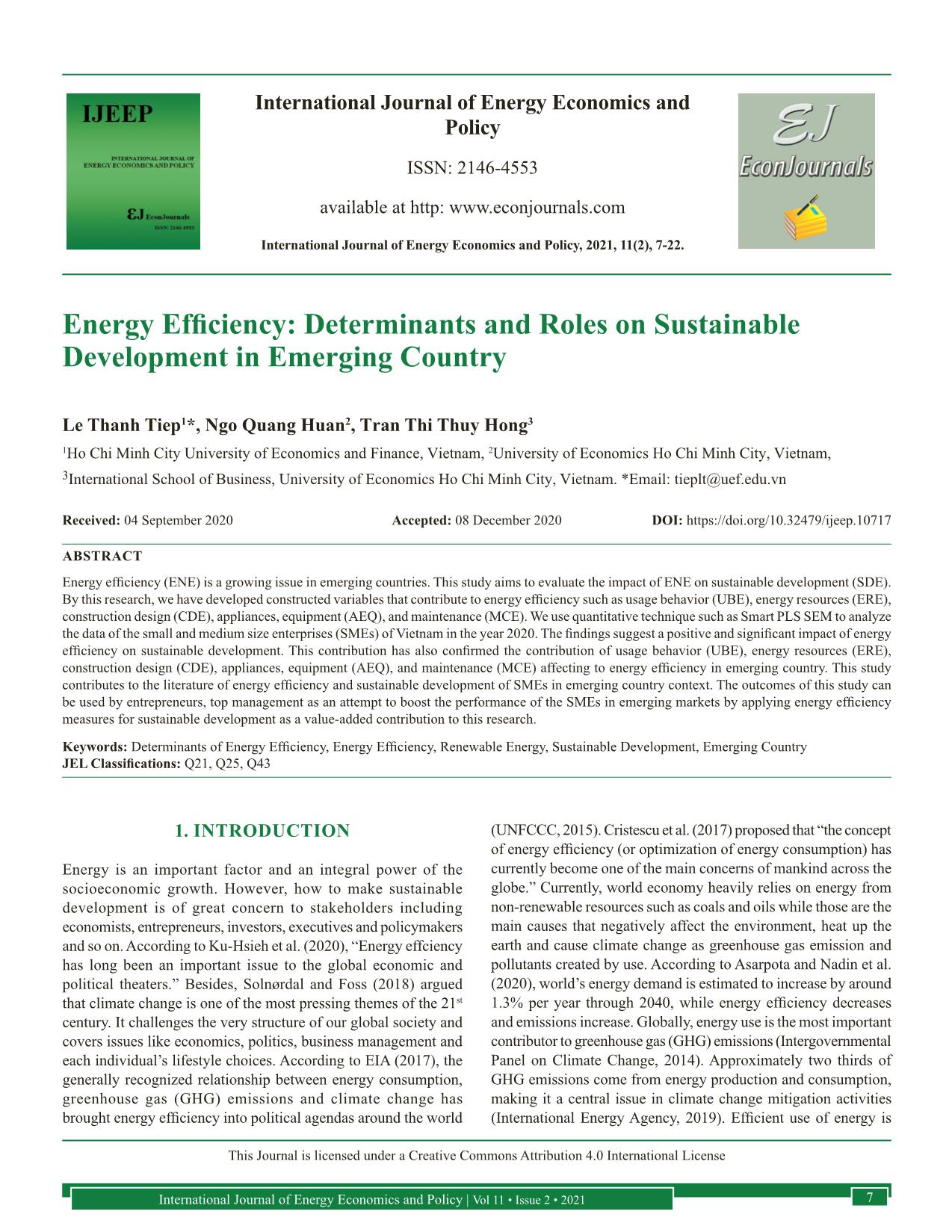
Trang 1
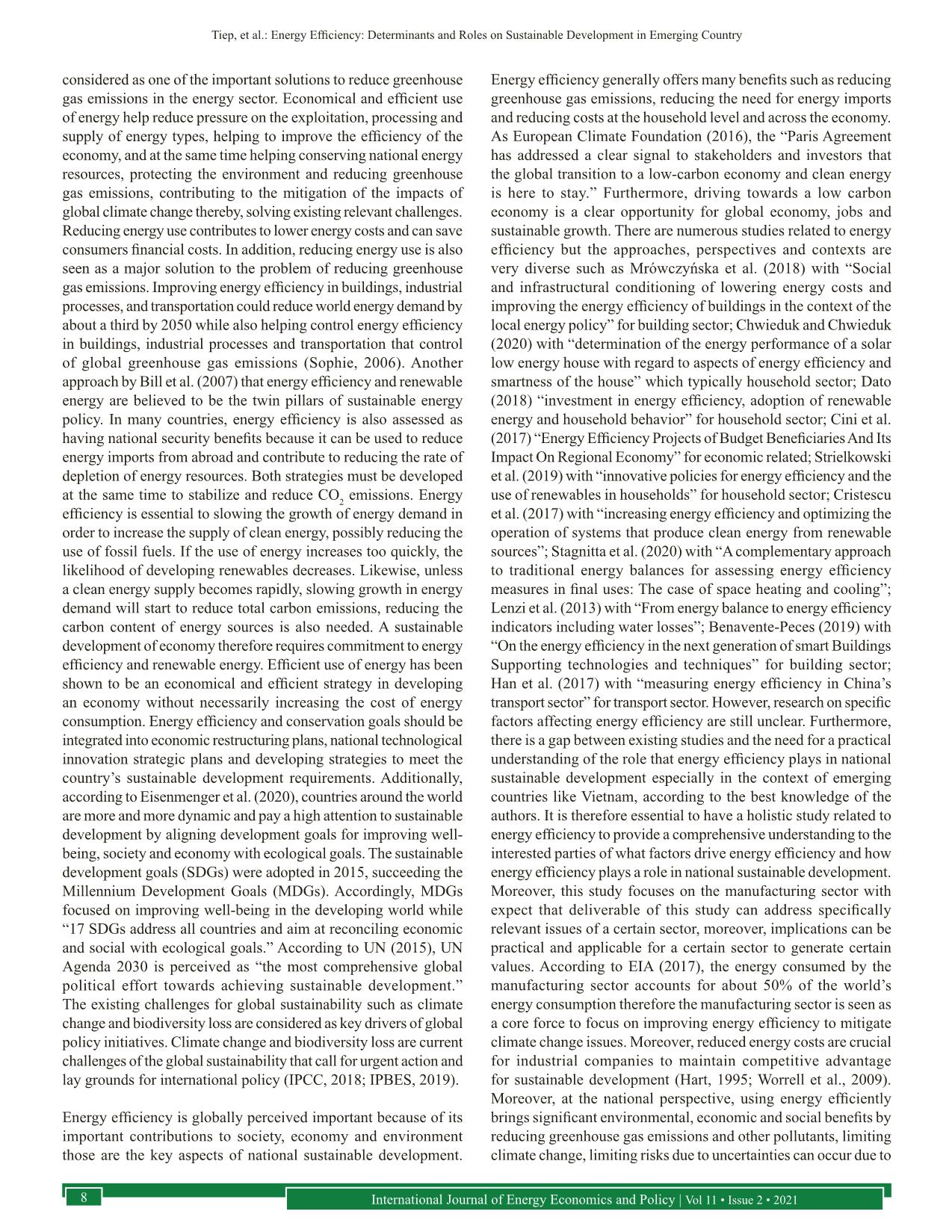
Trang 2
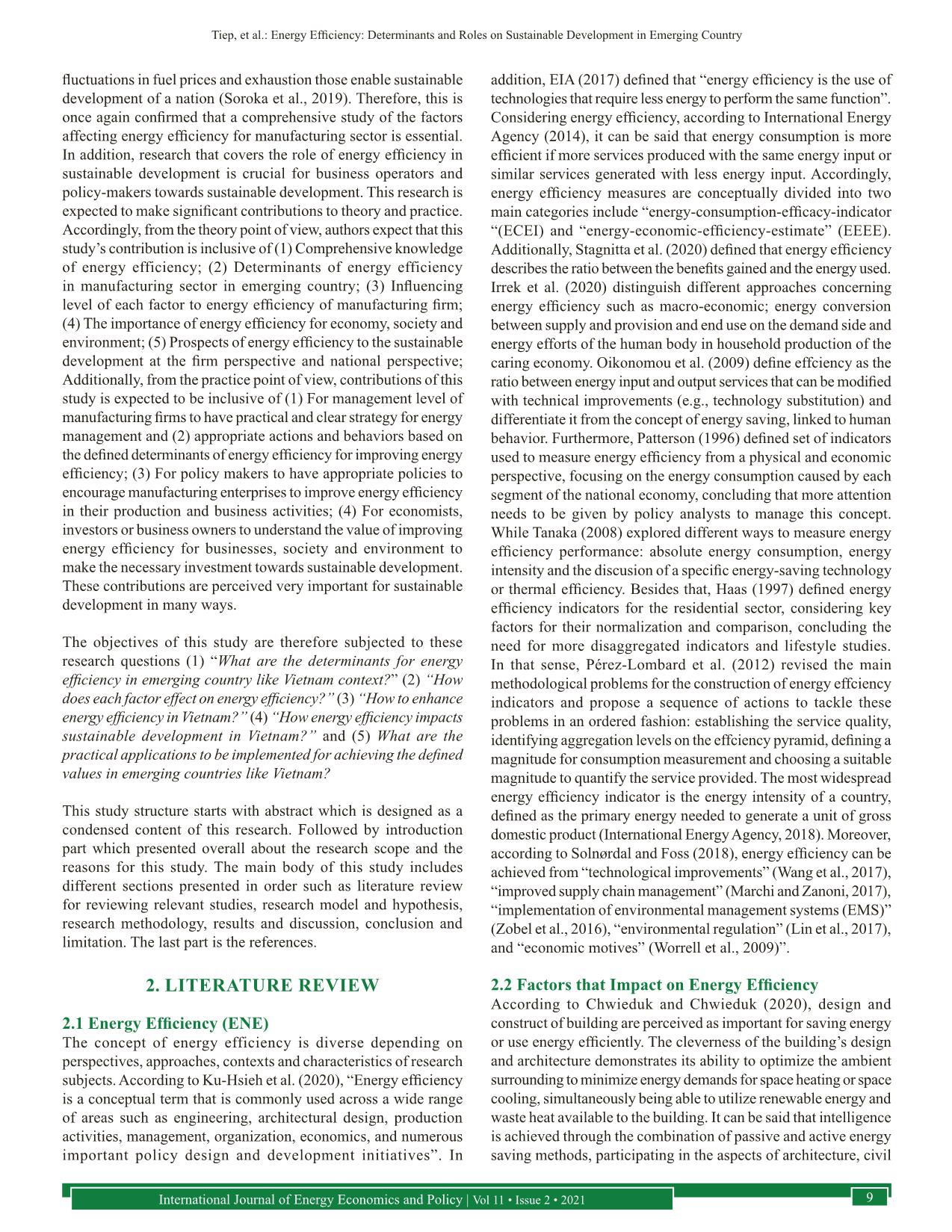
Trang 3
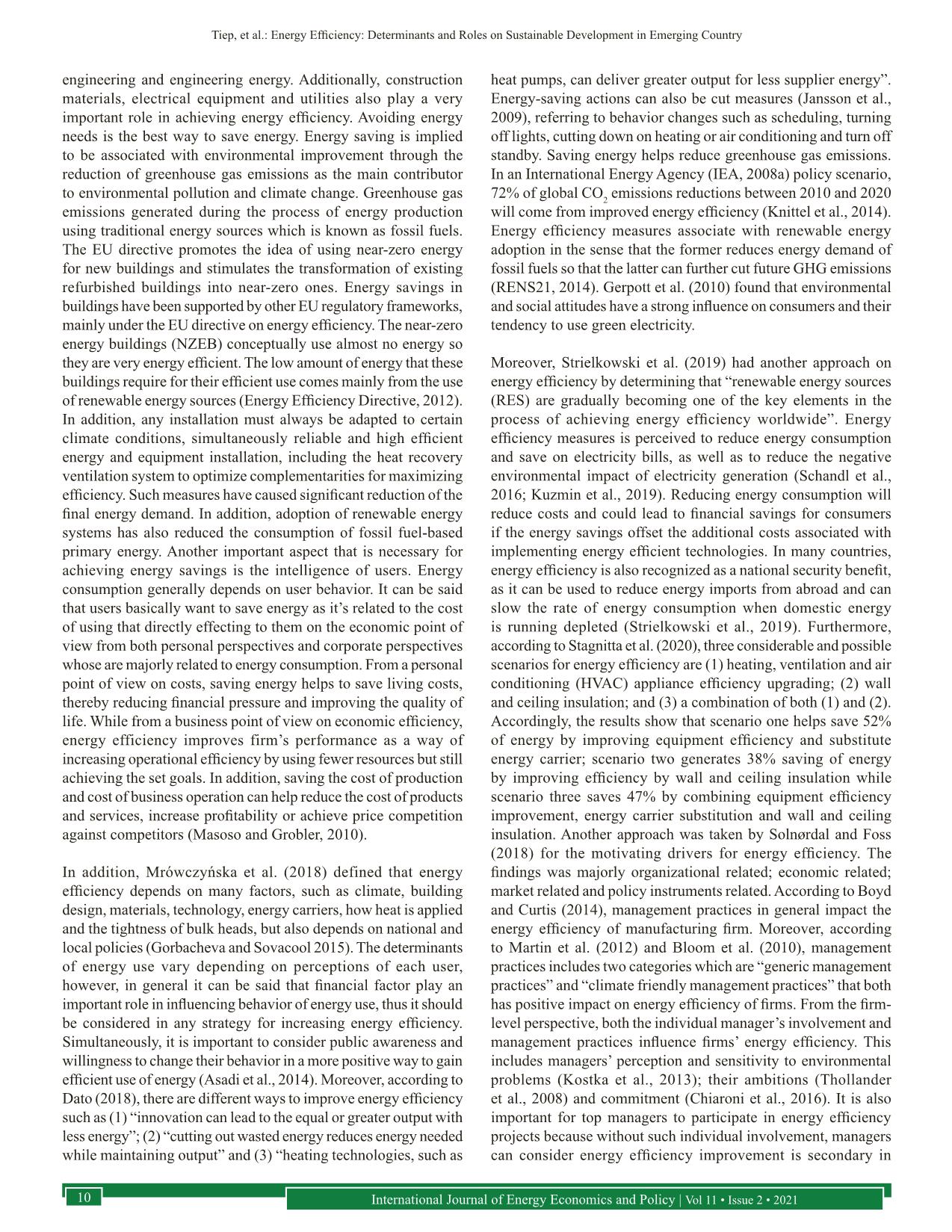
Trang 4
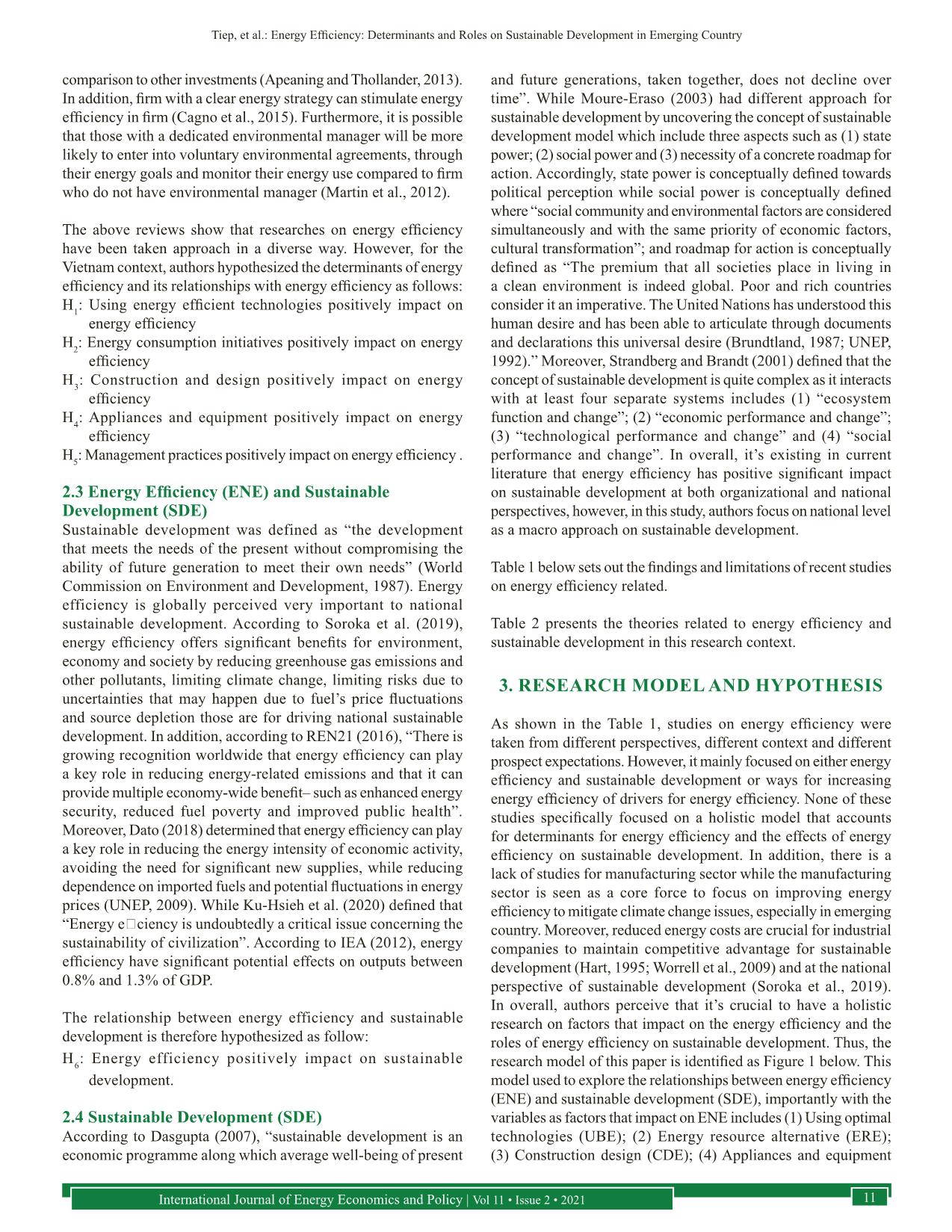
Trang 5
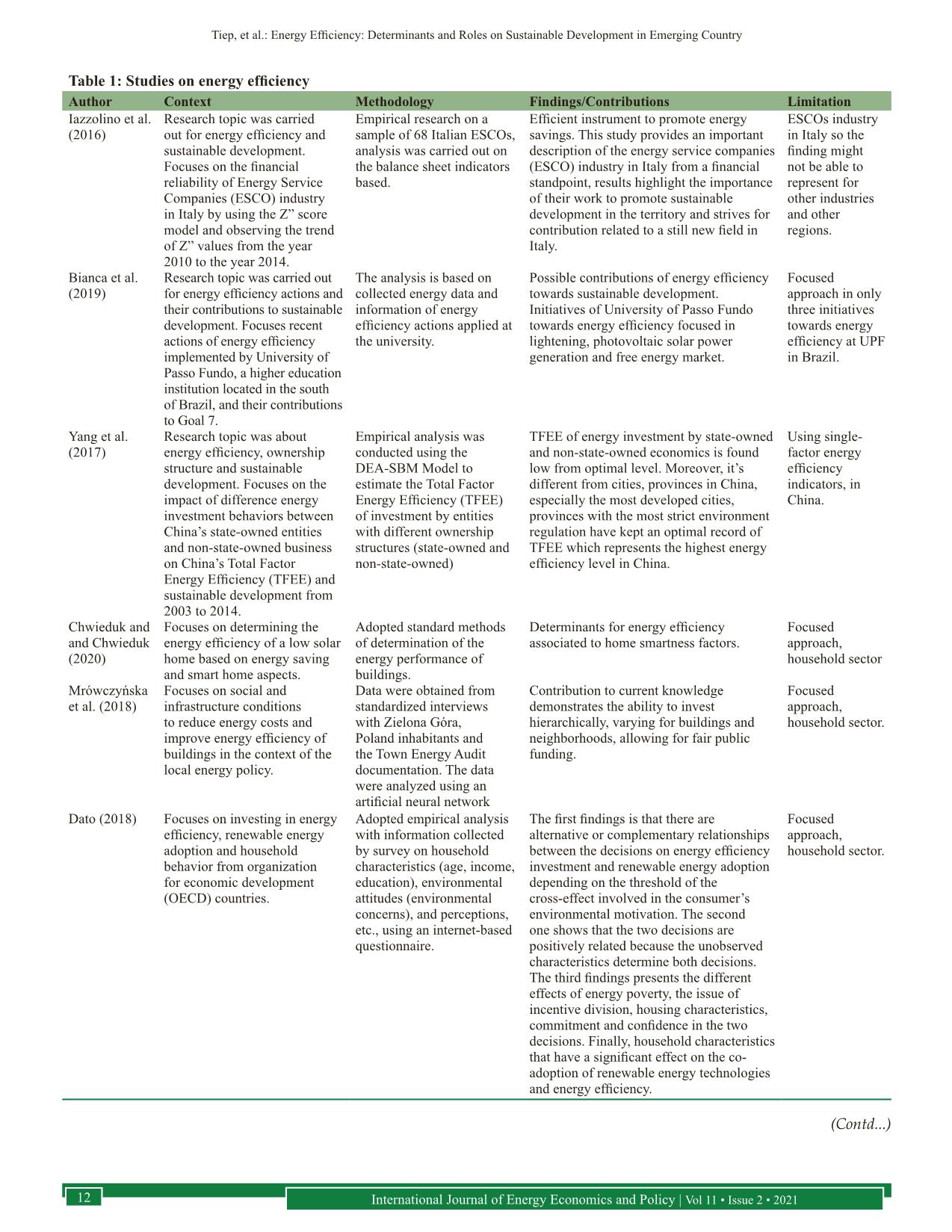
Trang 6
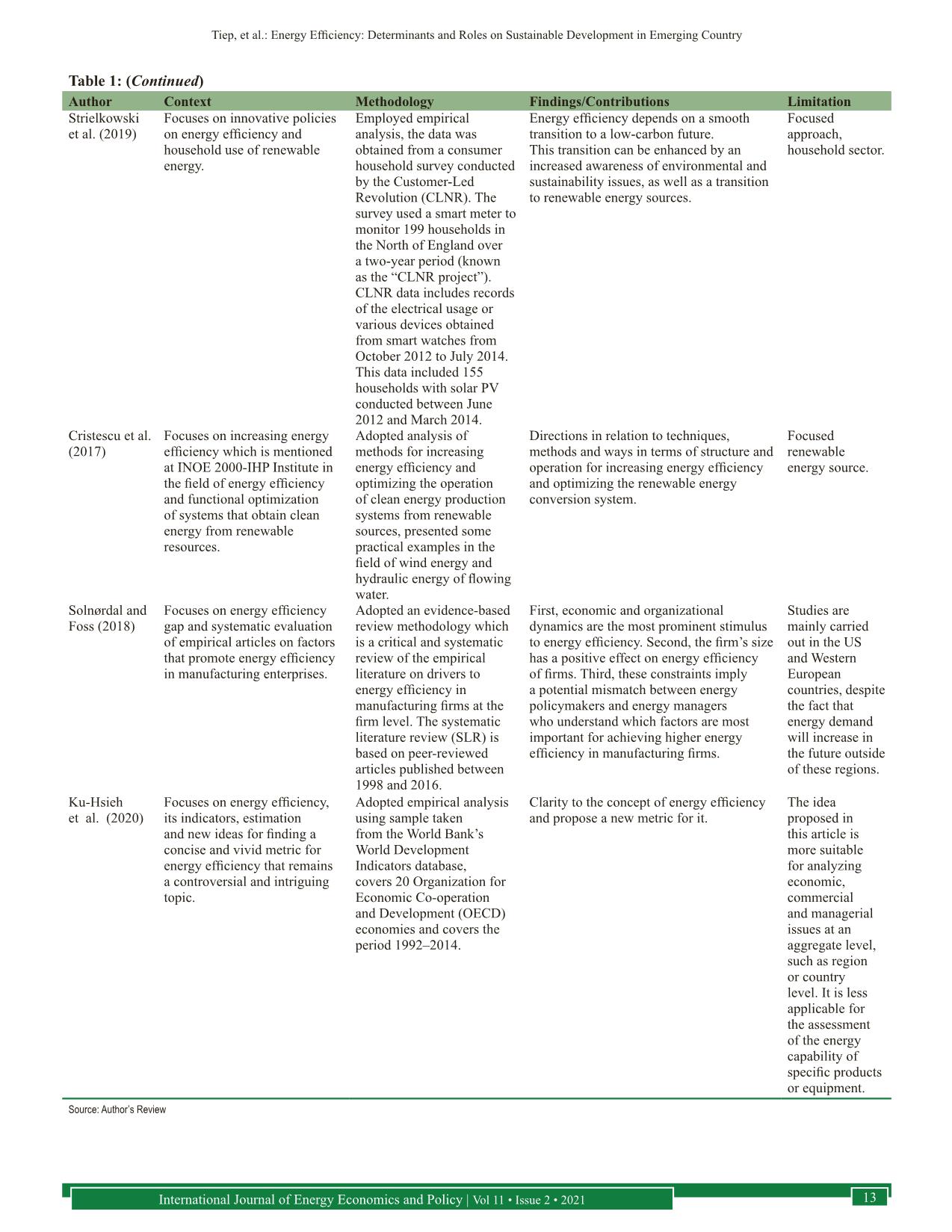
Trang 7
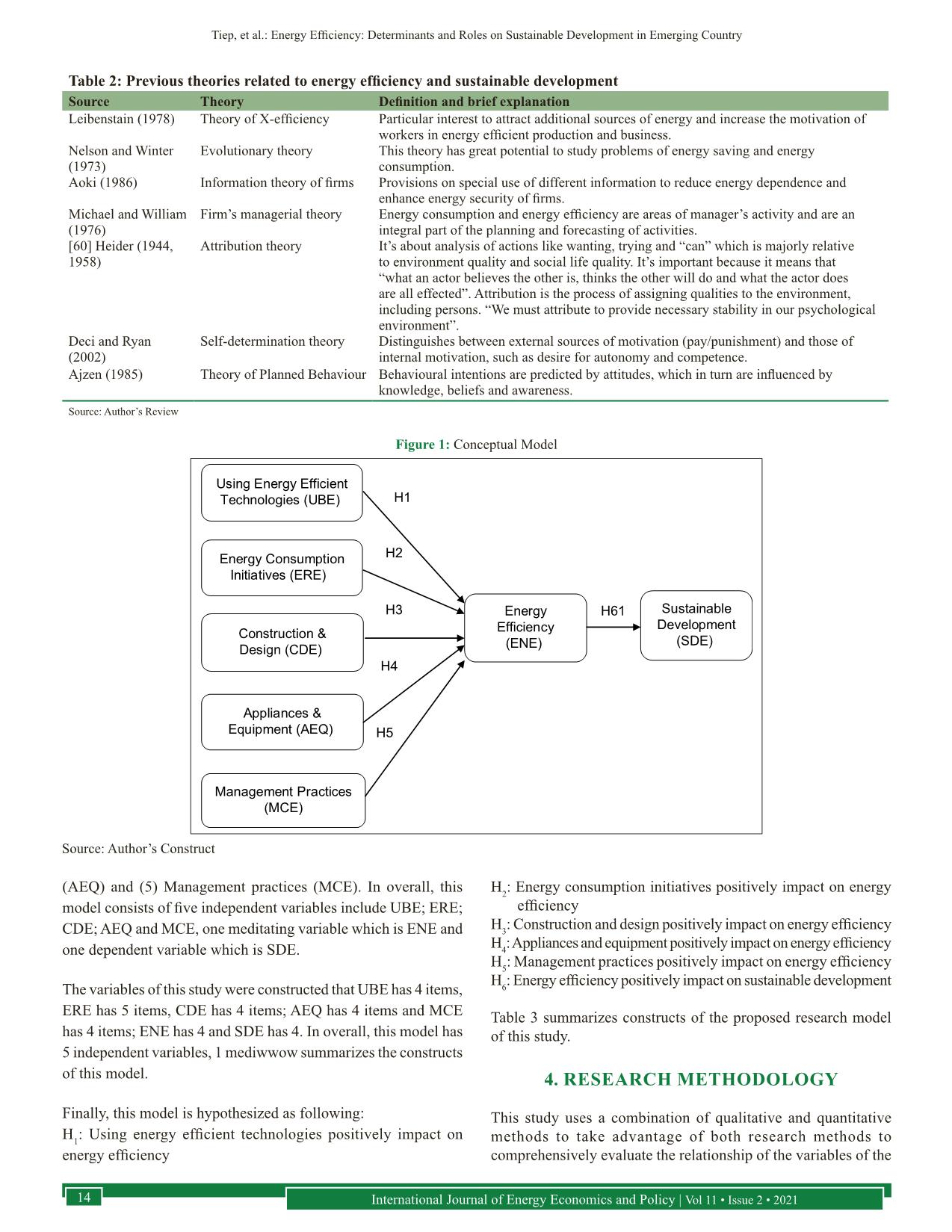
Trang 8
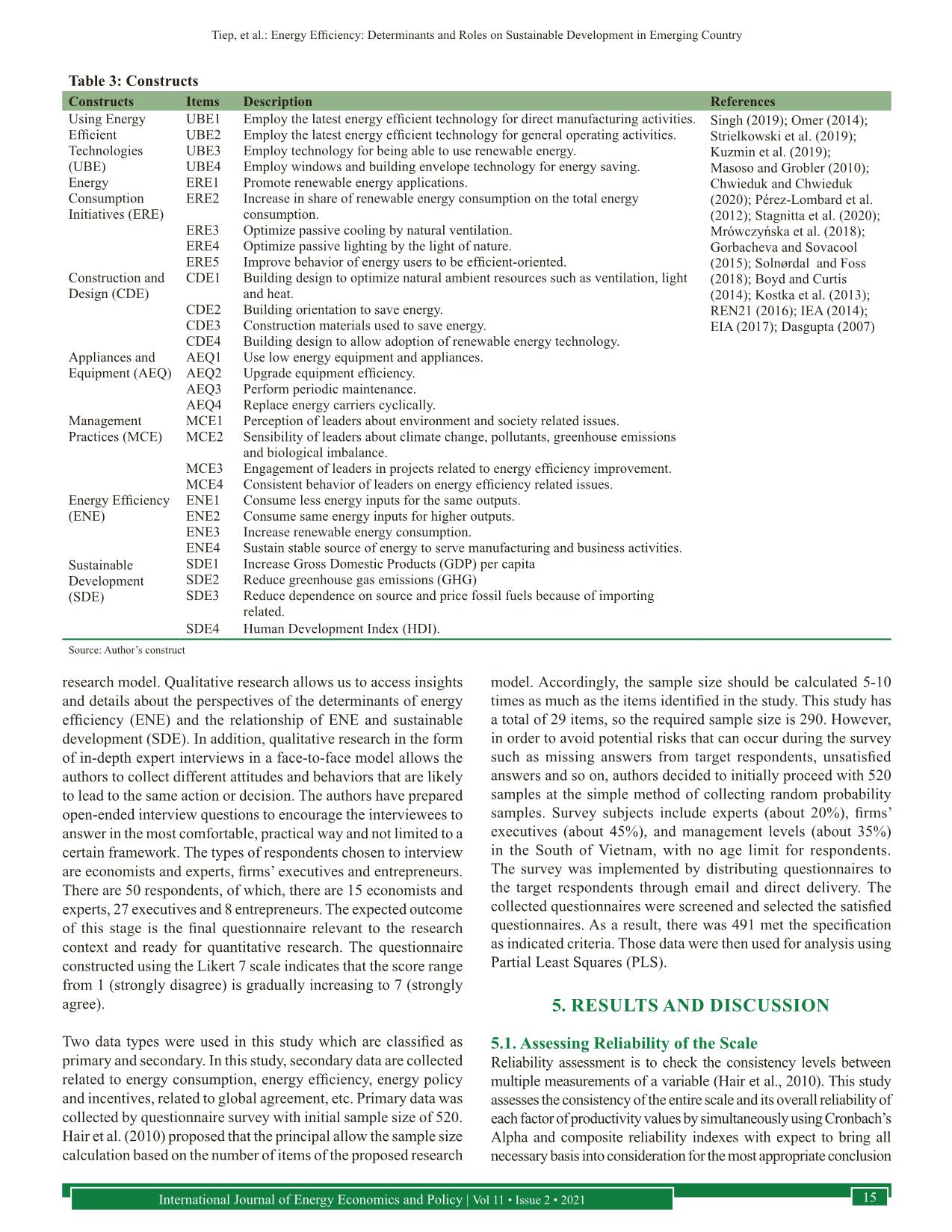
Trang 9
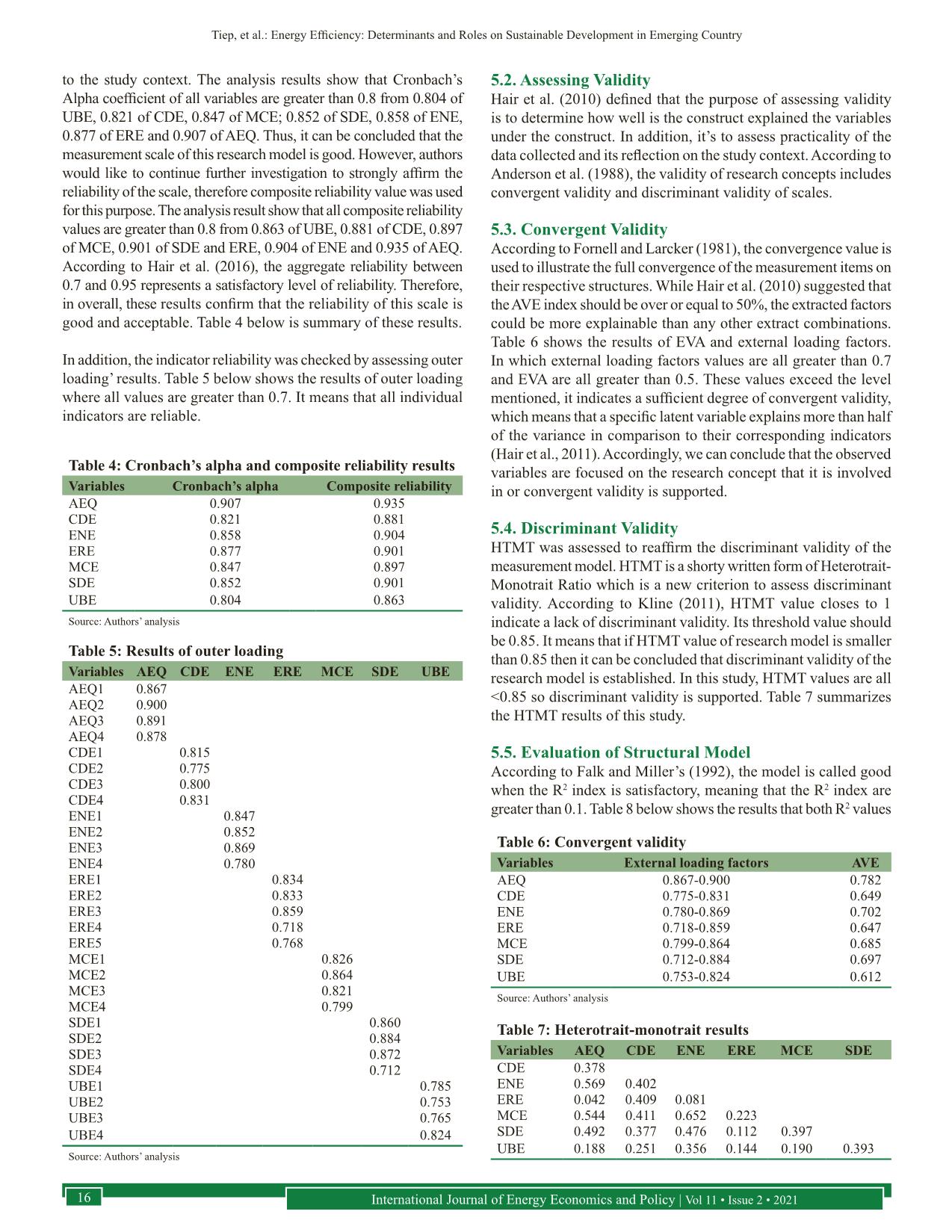
Trang 10
Tải về để xem bản đầy đủ
Tóm tắt nội dung tài liệu: Energy efficiency: Determinants and roles on sustainable development in emerging country
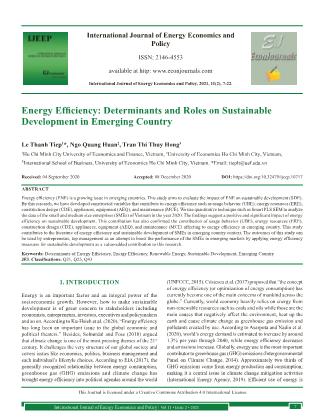
UK: Oxford University Press. Cagno, E., Trianni, A. (2014), Evaluating the barriers to specific industrial energy efficiency measures: An exploratory study in small and medium-sized enterprises. Journal of Cleaner Production, 82(1), 70-83. Cenfetelli, R., Bassellier, G. (2009), Interpretation of formative measurement in information systems research. MIS Quarterly, 33(4), 689-708. Chiaroni, D., Chiesa, V., Franzò, S., Frattini, F., Latilla, V.M. (2016), Overcoming internal barriers to industrial energy efficiency through energy audit: A case study of a large manufacturing company in the home appliances industry. Clean Technologies and Environmental Policy, 19, 1-16. Chwieduk, D., Chwieduk, M. (2020), Determination of the energy performance of a solar low energy house with regard to aspects of energy efficiency and smartness of the house. Energies, 13(12), 3232. Cini, V., Drvenkar, N., Candrlic-Dankos, I. (2017), Energy Efficiency Projects of Budget Beneficiaries and its Impact on Regional Economy. Varazdin: Varazdin Development and Entrepreneurship Agency. Available from: https://www.search.proquest.com/docview /2070396980?accountid=63189. Cristescu, C., Dumitrescu, C., Dulgheru, V., Popescu, T.C. (2017), Increasing energy efficiency and optimizing the operation of systems that produce clean energy from renewable sources. Hidraulica, 3, 62-73. Dasgupta, P. (2007), Measuring sustainable development: Theory and application. Asian Development Review, 24(1), 1-10. Dato, P. (2018), Investment in energy efficiency, adoption of renewable energy and household behavior: Evidence from OECD countries. The Energy Journal, 39(3), 1-2. Deci, E.L., Ryan, R.M., editors. (2002), Handbook of Self-Determination Research. Rochester, New York: University of Rochester Press. Efron, B., Tibshirani, R. (1993), An Introduction to the Bootstrap. New York: Chapman and Hall. EIA. (2017), Energy Efficiency and Conservation. Available from: http:// www.eia.gov/energyexplained/index.cfm?page=about_energy_ efficiency. [Last accessed on 2017 Jul 07]. Eisenmenger, N., Pichler, M., Nora, K., Dominik, N., Plank, B., Ekaterina, S., Wandl, MT., Gingrich, S. (2020), The sustainable development goals prioritize economic growth over sustainable resource use: A critical reflection on the SDGs from a socio- ecological perspective. Sustainability Science, 15(4), 1101-1110. Energy Information Administration (EIA). (2017), International Energy Outlook 2017. Washington, DC, USA: U.S. Energy Information Administration. p76. EU Climate and Energy Commissioner Miguel Arias Cañete. (2016), European Climate Foundation. Available from: https://www. ec.europa.eu/commission/presscorner/detail/en/speech_16_586. Falk, R.F., Miller, N.B. (1992), A Primer for Soft Modeling. Ohio: The University of Akron Press. Fornell, C., Larcker, D. (1981), Evaluating structural equations models with unobservable variables and measurement error. Journal of Marketing, 18(1), 39-50. Gerpott, T.J., Mahmudova, I. (2010), Determinants of green electricity adoption among residential customers in Germany. International Journal of Consumer Studies, 34(4), 464-473. Gorbacheva, N., Sovacool, B. (2015), Pain without gain? Reviewing the risks and rewards of investing in Russian coal-fired electricity. Applied Energy, 154, 970-986. Haas, R. (1997), Energy efficiency indicators in the residential sector. Energy Policy, 25, 789-802. Hair, J.F., Black, W.C., Babin, B.J., Anderson, R.E. (2009), Multivariate Data Analysis. Upper Saddle River, New Jersey: Prentice Hall. Hair, J.F., Hult, G.T.M., Ringle, C., Sarstedt, M. (2016), A Primer on Partial Least Squares Structural Equation Modeling (PLS-SEM). 2nd ed. United States: Sage Publications. Hair, J.F., Black, W.C., Babin, B.J., Anderson, R.E. (2010), Multivariate Data Analysis. 7th ed. Upper Saddle River, New Jersey: Prentice Hall. Han, H., Liu, F., Liu, Z., Zhao, F. (2017), Measuring energy efficiency in China’s transport sector. Energies, 10(5), 660. Hart, S.L. (1995), A natural-resource-based view of the firm. Academy of Management Review, 20, 986-1014. Heider, F. (1944), Social perception and phenomenal causality. Psychological Review, 51, 358374. Heider, F. (1958), The Psychology of Interpersonal Relations. New York: Wiley. Hu, L., Bentler, P. (1999), Cutoff criteria for fit indices in covariance structure analysis: Conventional criteria versus new alternatives. Structural Equation Modeling, 6, 1-55. Iazzolino, G., Gabriele, R. (2016), Energy efficiency and sustainable development: An analysis of financial reliability in energy service companies industry. International Journal of Energy Economics and Policy, 6(2), 1-12. Available from: https://www.search.proquest.com/ docview/1815332621?accountid=63189. IEA. (2008a), Energy Technology Perspectives, 2008: Scenarios and Strategies to 2050: In Support of the G8 Plan of Action. Technical Report. Paris: International Energy Agency. Intergovernmental Panel on Climate Change. (2014), Summary for Policymakers: Climate Change 2014: Mitigation of Climate Change. Contribution of Working Group 3 to the Fifth Assessment Report of the Intergovernmental Panel on Climate Change. Geneva, Switzerland: Intergovernmental Panel on Climate Change. Tiep, et al.: Energy Efficiency: Determinants and Roles on Sustainable Development in Emerging Country International Journal of Energy Economics and Policy | Vol 11 • Issue 2 • 2021 21 International Energy Agency. (2012), World Energy Outlook. Paris: IEA. International Energy Agency. (2014), Energy Efficiency Indicators: Essential for Policy Making 2014. Available from: https://www.iea. org/publications/freepublications. [Last accessed on 2020 Feb 23]. International Energy Agency. (2019), World Energy Outlook 2019. Amsterdam, Netherlands: International Energy Agency. International Energy Agency. (2018), World Energy Statistics 2018. Available from: https://www.iea.org/reports. [Last accessed on 2020 Mar 06]. IPBES. (2019), Global Assessment Report on Biodiversity and Ecosystem Services of the Intergovernmental Science-Policy Platform on Biodiversity and Ecosystem Services. Bonn: IPBES. IPCC. (2018), Summary for policymakers. In: Global Warming of 1.5° C. An IPCC Special Report on the Impacts of Global Warming of 1.5° C above Pre-Industrial Levels and Related Global Greenhouse Gas Emission Pathways, in the Context of Strengthening the Global Response to the Threat of Climate Change, Sustainable Development, and Efforts to Eradicate Poverty. Geneva, Switzerland: World Meteorological Organization. p32. Irrek, W., Thomas, S. (2020), Defining Energy Efficiency. Available from: https://www.wupperinst.org/fa/redaktion/downloads/misc/ energy_effciency_definition.pdf. [Last accessed on 2020 Mar 06]. Jansson, J., Marell, A., Nordlund, A. (2009), Elucidating green consumers: A cluster analytic approach on pro-environmental purchase and curtailment behaviors. Journal of Euromarketing, 18(4), 245. Kline, R.B. (1998), Principles and Practice of Structural Equation Modeling. New York: The Guilford Press. Kline, R.B. (2011), Principles and Practice of Structural Equation Modeling. New York: The Guilford Press. Knittel, C.R., Greenstone, M., Carlos, T. (2014), Understanding the Economics of Energy Efficiency. Kostka, G., Moslener, U., Andreas, J. (2013), Barriers to increasing energy efficiency: Evidence from small-and medium-sized enterprises in China. J Journal of Cleaner Production, 57, 59-68. Ku-Hsieh, C., Jen-Chi, C., Joe-Ming, L., Liou-Yuan, L., Sheng-Yu, P. (2020), Energy efficiency: Indicator, estimation, and a new idea. Sustainability, 12(12), 4944. Kuzmin, E.A., Volkova, E.E., Fomina, A.V. (2019), Research on the concentration of companies in the electric power market of Russia. International Journal of Energy Economics and Policy, 9, 130-136. Leibenstain, H. (1978), General X-Efficiency Theory and Economic Development. New York: Oxford University Press. Lenzi, C., Bragalli, C., Bolognesi, A., Artina, S. (2013), From energy balance to energy efficiency indicators including water losses. Water Science and Technology, 13(4), 889-895. Lin, J., Xu, C. (2017), The impact of environmental regulation on total factor energy efficiency: A cross-region analysis in China. Energies, 10, 1578. Marchi, B., Zanoni, S. (2017), Supply chain management for improved energy efficiency: Review and opportunities. Energies, 10, 1618. Martin, R., Muûls, M., de Preux, L.B., Wagner, U.J. (2012), Anatomy of a paradox: Management practices, organizational structure and energy efficiency. Journal of Environmental Economics and Management, 63, 208-223. Masoso, O.T., Grobler, L.J. (2010), The dark side of occupants’ behavior on building energy use. Energy and Buildings, 42, 173-177. Michael, J., William, H.M. (1976), Theory of the firm: Managerial behavior, agency costs and ownership structure. Journal of Financial Economics, 3(4), 305-360. Moure-Eraso, R. (2003), Development models, sustainability and occupational and environmental health in the Americas: Neoliberalism versus sustainable theories of development. Ciência and Saúde Coletiva, 8(4), 1039-1046. Mrówczyńska, M., Skiba, M., Bazan-Krzywoszańska, A., Bazuń, D., Kwiatkowski, M. (2018), Social and infrastructural conditioning of lowering energy costs and improving the energy efficiency of buildings in the context of the local energy policy. Energies, 11(9), 2302. Nelson, R.R., Winter, G.S. (1973), Toward evolutionary theory of economic capabilities. The American Economic Review, 63(2), 440-449. Oikonomou, V., Becchis, F., Steg, L., Russolillo, D. (2009), Energy saving and energy efficiency concepts for policy making. Energy Policy, 37, 4787-4796. Omer, A.M. (2014), Energy efficiency improvement Utilising high technology: The path forward for renewable energy use in industry, buildings and sustainable development. Blue Biotechnology Journal, 3(2), 183-250. Patterson, M.G. (1996), What is energy efficiency? Energy Policy, 24, 377-390. Pérez-Lombard, L., Ortiz, J., Velázquez, D. (2012), Revisiting energy effciency fundamentals. Energy Efficiency, 6, 239-254. Petter, S., Straub, D., Rai, A. (2007), Specifying formative constructs in information systems research. MIS Quarterly, 31(4), 623-656. Renewables 2016 Global Status Report. (2016), REN21 Renewable Energy Policy Network for 21st Century, Paris. Available from: report_lowres.pdf. RENS21. (2014), Renewable 2014 Global Status Report, Technical Report. Paris: REN21 Secretariat. Schandl, H., Hatfield-Dodds, S., Wiedmann, T., Geschke, A., Cai, Y., West, J., Newth, D., Baynes, T., Lenzen, M., Owen, A. (2016), Decoupling global environmental pressure and economic growth: Scenarios for energy use, materials use and carbon emissions. Journal of Cleaner Production, 132, 45-56. Singh, D. (2019), Implementation of technology innovation in MSMEs in India. Journal of Science and Technology Policy Management, 10(3), 769-792. Solnørdal, M.T., Foss, L. (2018), Closing the energy efficiency gap-a systematic review of empirical articles on drivers to energy efficiency in manufacturing firms. Energies, 11(3), 518. Sophie, H. (2006), Invest in Clean Technology Says IEA Report. Available from: https://www.scidev.net/global/biofuels/news/invest-in-clean- technology-says-iea-report.html. Soroka, L.C., Riabchenko, O.D., Zamryha, A.C., Korotun, O.C. (2019), State policy in the field of energy efficiency. Natsional’Nyi Hirnychyi Universytet. Naukovyi Visnyk, 4, 141-146. Stagnitta, R.G., Rocco, M.V., Colombo, E. (2020), A complementary approach to traditional energy balances for assessing energy efficiency measures in final uses: The case of space heating and cooling in Argentina. Sustainability, 12(16), 6563. Strandberg, L., Brandt, N. (2001), Sustainable development in theory and practice: An inter-Nordic internet course for regional and local officials and practitioners. International Journal of Sustainability in Higher Education, 2(3), 220-225. Strielkowski, W., Volkova, E., Pushkareva, L., Streimikiene, D. (2019), Innovative policies for energy efficiency and the use of renewables in households. Energies, 12(7), 1392. Tanaka, K. (2008), Assessment of energy effciency performance measures in industry and their application for policy. Energy Policy, 36, 2887-2902. The Energy Effciency Directive. (2012), The Energy Effciency Directive (2012/27/EU) of the European Parliament and of the Council of 25 October 2012 on Energy Efficiency. Available from: data.europa.eu/eli/dir/2012/27/oj. [Last accessed on 2020 May 10]. Thollander, P., Danestig, M., Rohdin, P. (2007), Energy policies for increased industrial energy efficiency: Evaluation of a local energy Tiep, et al.: Energy Efficiency: Determinants and Roles on Sustainable Development in Emerging Country International Journal of Energy Economics and Policy | Vol 11 • Issue 2 • 202122 programme for manufacturing SMEs. Energy Policy, 35, 5774-5783. UN. (2015), Sustainable Development Goals, Sustainable Development Knowledge Platform. Available from: https://www. sustainabledevelopment.un.org/topics/sustainabledevelopmentgoals. [Last accessed on 2015 Apr 19]. UN. (2015), Best Policy Practice: For Promoting Energy Efficiency. A Structured Framework of Best Practice in Policies to Promote Energy Efficiency for Climate Change Mitigation and Sustainable Development, UNECE Energy Series No. 43. New York, Geneva: United Nations. UNEP. (2009), Energy Efficiency and the Finance Sector: A Survey on Lending Activities and Policy Issues. A Report Commissioned by UNEP Finance Initiative’s Climate Change Working Group. Geneva: UNEP Finance Initiative. UNEP. (1992), The Global Partnership for Environment and Development. A Guide to Agenda No. 21. UNFCCC. (2015), Adoption of the Paris Agreement UN: UN. Available from: https://www.unfccc.int/resource/docs/2015/cop21/eng/l09r01. pdf. [Last accessed on 2018 Feb 08]. Wang, C.N., Ho, H.X., Hsueh, M.H. (2017), An integrated approach for estimating the energy efficiency of seventeen countries. Energies, 10, 1597. World Commission on Environment and Development (WCED). (1987), Our Common Future. New York: Oxford University Press. Worrell, E., Bernstein, L., Roy, J., Price, L., Harnisch, J. (2009), Industrial energy efficiency and climate change mitigation. Energy Efficiency, 2, 109-123. Yang, W., Li, L. (2017), Energy efficiency, ownership structure, and sustainable development: Evidence from china. Sustainability, 9(6), 912. Zobel, T., Malmgren, C. (2016), Evaluating the management system approach for industrial energy efficiency improvements. Energies, 9, 774.
File đính kèm:
 energy_efficiency_determinants_and_roles_on_sustainable_deve.pdf
energy_efficiency_determinants_and_roles_on_sustainable_deve.pdf

